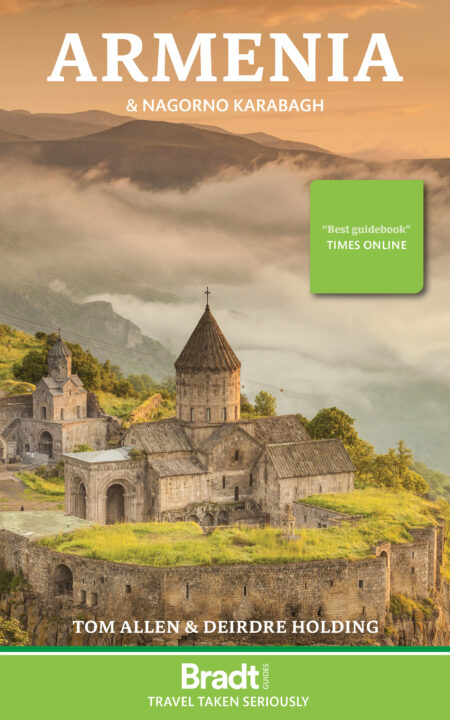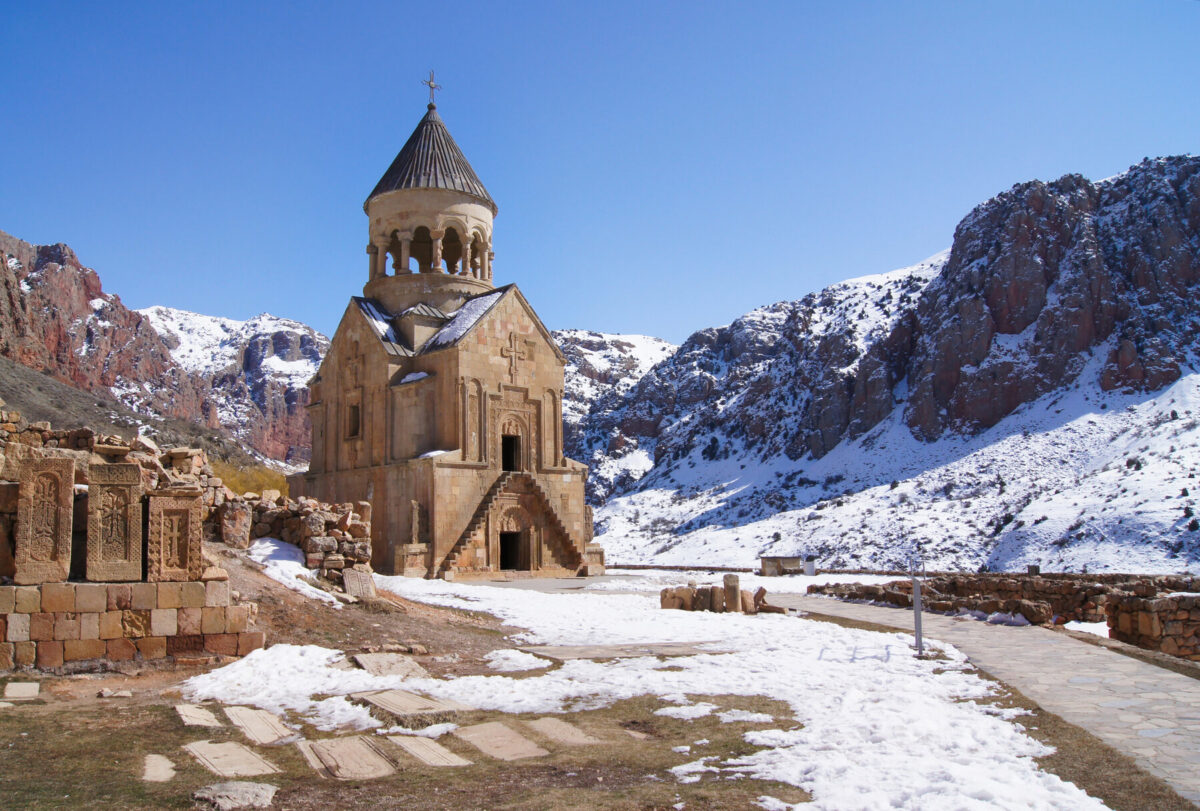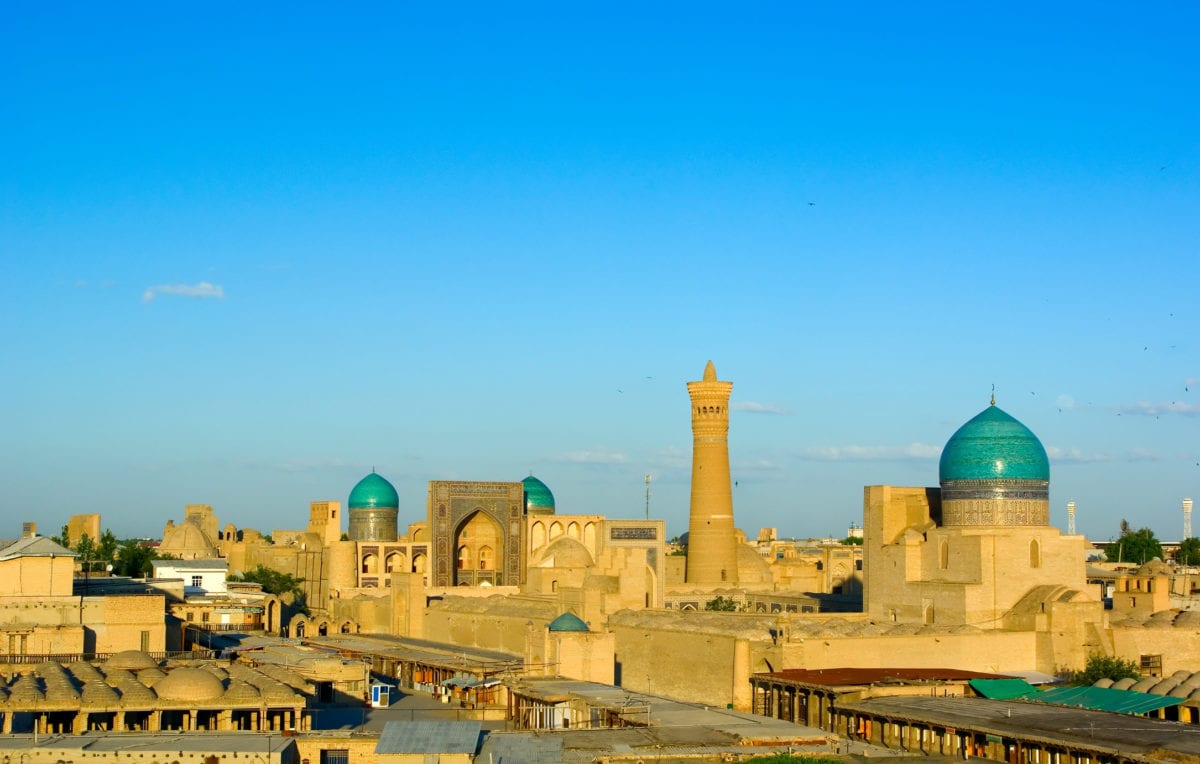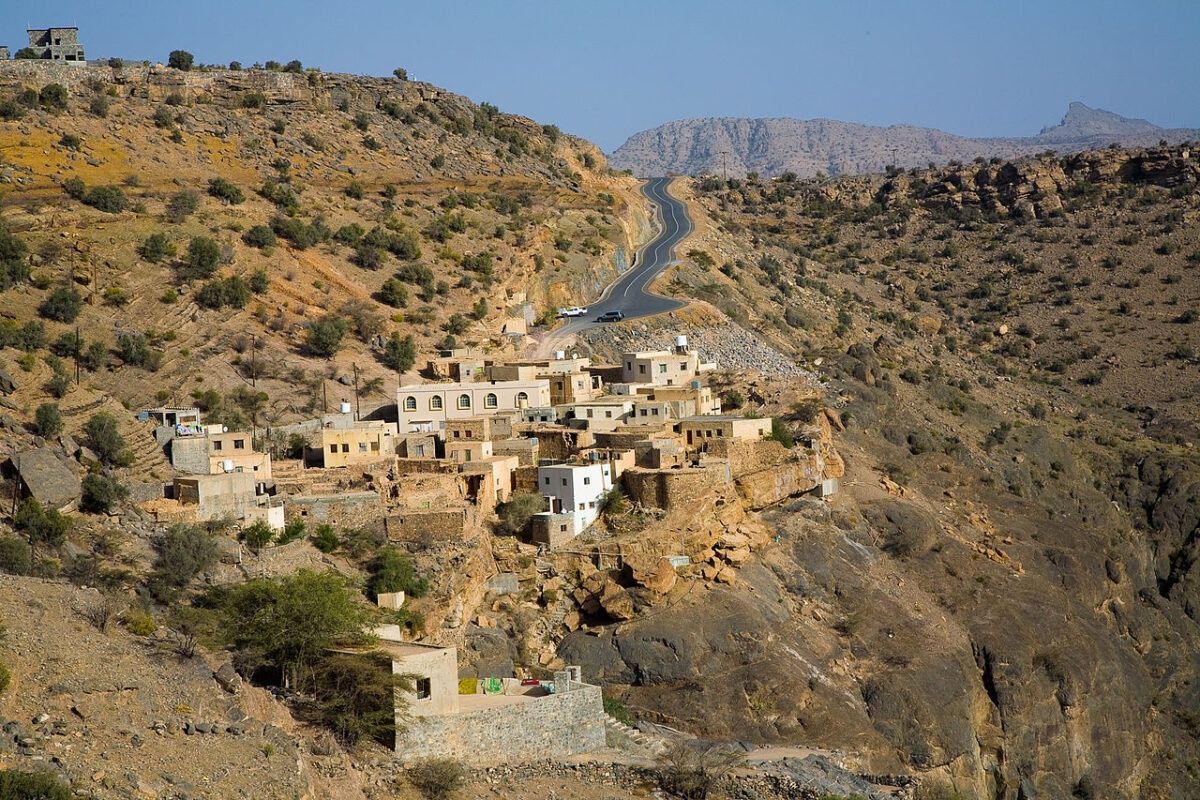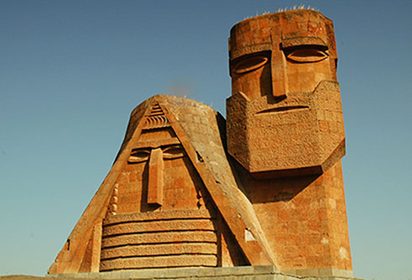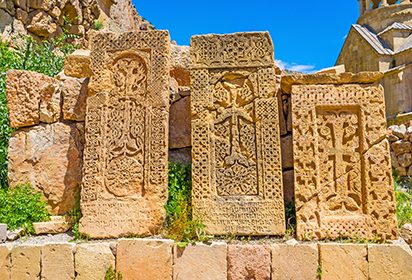Armenia has so much to offer visitors. It will never become a mainstream tourist destination like Mallorca or Florida but few visitors to Armenia leave disappointed, apart from wishing that they had had more time in the country.
Deirdre Holding and Tom Allen, authors of Armenia: the Bradt Guide
Steeped in history and rich with stunning scenery, Armenia is a captivating country. Discover ancient monasteries above dramatic gorges, marvel at the field of 900 intricately carved khachkars at Noratus, wonder at millennia-old petroglyphs high in snow-capped mountains and soak up the culture at the markets and museums of Yerevan. Add to this the warm welcome of the locals and the tastiest apricots in the world, and visitors are sure to be enchanted.
Much of Armenia’s fascinating and diverse character stems from its position at the centre of so many cross-roads: geological and geographical, historical and political, biological and religious. The Armenian language with its own unique alphabet adds yet another dimension.
Armenia’s cultural significance is recognised by UNESCO. The symbolism and craftsmanship of khachkars is inscribed on UNESCO’s Intangible Cultural Heritage list; the Matenadaran, one of the world’s largest depositories of medieval manuscripts and books (and home to Armenia’s superb illuminated manuscripts), is inscribed on UNESCO’s Memory of the World register and there are three UNESCO World Heritage Sites covering some of Armenia’s best-known cathedrals, churches and monasteries.
In addition to all this, the richness of its nature and wildlife and the wonderful quality of seasonal fruit and vegetables is incredible and it is hard to imagine anyone being disappointed. A trip to Armenia leaves most visitors with only one regret – that they did not have more time in the country.
Food and drink in Armenia
Food
Traditional Armenian cuisine has much in common with Turkish, Persian or Arab cooking, all of whose empires at one time made subjects of the Armenians. It has much less in common with the cooking of Russia, which also ruled Armenia but whose cuisine reached the country relatively recently and is unknown in diaspora communities elsewhere in the world.
Russia’s culinary legacy can be seen on the shelves of any mainstream supermarket and on most restaurant menus, as well as in some forms of street food.
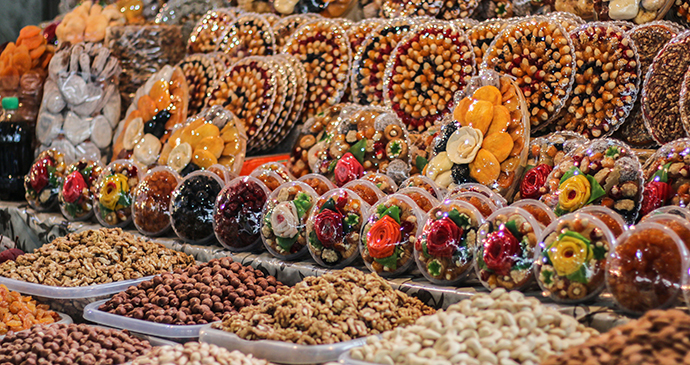
The quality of Armenia’s fruit and vegetables is notable, partly because Armenians grow what the climate favours, partly because the produce has not travelled from another continent, and partly because flavour is considered more important than size or appearance. Apricots, native to Armenia, are probably the most famous produce, but throughout the growing season you’ll find market sellers and the ubiquitous roadside vendors piling their stalls with various other fresh produce.
The main meal is eaten in the evening. Bread will certainly be provided, usually lavash, but some restaurants, particularly in Yerevan, will also include a selection of regular leavened breads in the same basket. The meal usually begins with a selection of salads which can incorporate both raw and cooked vegetables, peas, beans, herbs, fruits, nuts, bulghur, eggs and meat.
In season romaine lettuce is used but in winter cabbage is substituted. The main course is usually based on meat or fish. Fish is obviously less common than in countries which are not landlocked but common whitefish (sig) from Lake Sevan is sometimes available and also trout (ishkhan) from Armenia’s rivers. Trout and sturgeon are available from the Armash fishponds and other fishfarms.
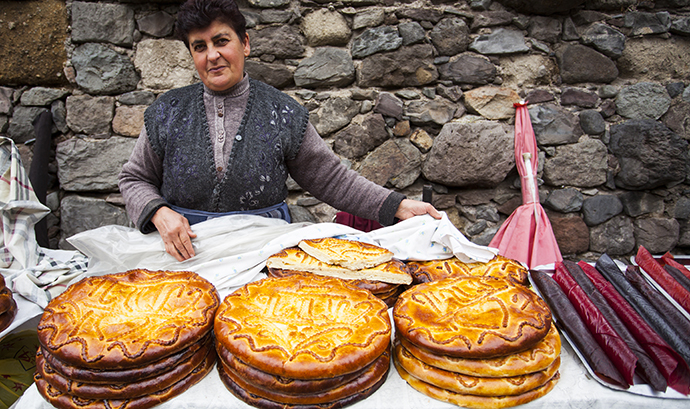
Lamb (gar), mutton (vochkhar) and beef (tavar) are all popular and a huge variety of meat stews are cooked in domestic homes with ingredients from quinces (ms’sov serkevil) and apricots (ms’sov tsiran) to artichokes (ms’sov gangar) and leeks (ms’sov bras).
These fascinating, delicious and often celebratory dishes are usually served with a rice pilaff (brndzov plav) or bulghur pilaff (dzavari plav), but the chance of finding one on a restaurant menu is practically zero. You will, however, find lots of barbecues (khorovats) using lamb, pork (khoz), beef, chicken or, occasionally, veal (hort), of which pork and chicken are usually the safest options.
Drink
Armenia is justly renowned for its brandy, its coffee and its spring water. Other drinks, such as some of the herbal teas – particularly the thyme (oorts) tea – are well worth trying, and the modernisation of the wine industry has led to a noticeable up-tick in the quality of local wines
Health and safety in Armenia
Health
With Dr Felicity Nicholson
All travellers to Armenia should ensure that they are up to date with immunisation against tetanus, polio and diphtheria (now given in the UK as an all-in-one vaccine, Revaxis, which lasts for ten years), and hepatitis A. Hepatitis A vaccine (eg: Havrix Monodose or Avaxim) comprises two injections given about a year apart. The course costs about £120 (but may be available on the NHS), it protects for 25 years and can be given even close to the time of departure.
Travellers to more remote areas or those visiting friends and relatives may be advised to be vaccinated against typhoid fever. In addition, some visitors, depending on what they are likely to be doing, may be advised to have protection against hepatitis B and rabies. Visitors should ensure that they take any essential medications with them as drugs can be difficult to access. Medications may have totally different names even when transliterated.
Travel clinics and health information
A full list of current travel clinic websites worldwide is available on www.istm.org. For other journey preparation information, consult www.travelhealthpro.org.uk (UK) or http://wwwnc.cdc.gov/travel/ (US). Information about various medications may be found on www.netdoctor.co.uk/travel. All advice found online should be used in conjunction with expert advice received prior to or during travel.
Safety
Most visits to Armenia are trouble free. Crime levels are low, but visitors should of course take sensible precautions. Generally, the risk of being a victim of crime is statistically much less likely than in most western European and American cities, and this notion is supported by countless anecdotal accounts of safe and trouble-free visits. Far greater risks are either tripping up on pavements in need of repair after dark or else falling into holes dug during the pavement’s reconstruction. Watch out, too, for missing manhole covers. These risks have reduced, at least in the centre of Yerevan, but can still be a problem elsewhere.
The military situation does mean that all areas along the 1994 ceasefire line with Azerbaijan should be avoided because of the presence of snipers on both sides, exchanges of fire between which still happen on a regular basis, affecting civilians living in the vicinity. The road from Ijevan to Noyemberyan, for example, is specifically warned against by British government-issued travel advice, but it is not the only afflicted area.
There remains a serious problem in areas of Nagorno Karabagh from mines and unexploded ordinance, as well as in adjoining areas of Armenia that experienced fighting. To the best of the authors’ knowledge, all places mentioned in this guide are safe to visit and sights where the unresolved conflict means that safety is problematic have been excluded or specifically highlighted as such. However, visitors to Nagorno Karabagh who do encounter difficulties should note that consular services are unavailable there.
Those wishing to procure more detailed information on the threat of landmines should refer to the websites of the HALO Trust for Nagorno Karabagh or the Armenian Centre for Humanitarian Demining and Expertise for Armenia itself, including the borders between Armenia and Nagorno Karabagh.
Visitors must not attempt to cross the borders with Georgia or Iran apart from at the recognised border crossings. Visitors are unlikely to be in great physical danger (unless attempting to swim the River Arax) but are at risk of being detained and questioned by the authorities, sometimes simply for taking photos within the vicinity.
Female travellers
There are no general safety problems for women as the strongly traditional family values ensure that they will not receive unwelcome attention; certainly, in cities and at the popular tourist sights. However, solo female travellers in remote, rural areas where foreigners are rarely encountered should take precautionary steps to avoid normal friendly behaviour being misinterpreted, as cultural misunderstandings have been known to happen.
Travelling with children
This is not a problem from the social aspect. They are welcome anywhere. Family life is important to Armenians – they would find the concept of a child not being allowed into a restaurant, for example, very strange. Nappies and baby food are available in Yerevan and other major towns, often from pharmacies.
Most restaurants and hotels will respond to parents’ requests about food preparation. In Yerevan, the Grand Candy café is specifically geared towards children and some other cafés have play areas. There are funfairs near the cathedral and in Victory Park, and amusements for smaller children in Children’s Park on Beirut Street. Some swimming pools have facilities for children, for example Waterworld, and good weather brings out street amusements in a number of towns.
LGBTQ+ travellers
Homosexuality was decriminalised in 2003 but is still an unacceptable lifestyle in Armenian society. The website of the NGO Pink Armenia provides a contemporary perspective on the ongoing social challenges facing the LGBT community.
The British government advises homosexual travellers to exercise discretion in Armenia. It is common in Armenian culture to see two female friends holding hands in the street and not uncommon to see two men hug and kiss each other in greeting; these signs of affection are not an indication of sexual orientation.
Travel and visas in Armenia
Visas
Citizens of all EU member states and Schengen Area member states are entitled to enter Armenia for up to 180 days per year without a visa, as are passport holders of various other countries including Australia, Georgia, New Zealand and the US. See the website of the Ministry of Foreign Affairs for the most up-to-date information.
Holders of passports from all other countries require a visa. The easiest way for visitors from eligible countries to obtain one is on arrival; again, consult the website above for the most up-to-date list. At Zvartnots International Airport, where most visitors arrive, it is straightforward and quick. Single-entry tourist visas are available for 21 or 120 days. The fee must be paid in Armenian drams (AMD3,000 for a 21-day visa, AMD15,000 for a 120-day visa).
The second method, which is compulsory for certain nationalities, is to apply for a conventional visa through an Armenian embassy abroad. The application form for a conventional visa can be downloaded from the Ministry of Foreign Affairs website and applications should be made to the appropriate embassy. The fees for a conventional visa are the same as for those obtained on arrival. Visas for children under 18 are issued free of charge. Multipleentry visas are only available through an embassy.
Getting there and away
By air
Yerevan has two airports, at Zvartnots International 10km west of the city and Erebuni (now used only by the military) closer to the centre on the south side. Direct air routes to and from Yerevan tend to reflect the locations of major Armenian diaspora communities within flying distance, particularly in Russia, Europe and the Middle East, though other routes have begun to spring up as tourist numbers increase.
Armenia Aircompany is now the only Armenian airline operating international commercial passenger flights, serving destinations in Russia, the Middle East and Europe. Many foreign airlines operate routes to Yerevan.
However, there are currently no direct flights from London, nor indeed from most western European capitals besides those with significant Armenian communities (such as Paris and Vienna). Air travel from Europe to Armenia therefore tends to involve at least one change of plane and relatively high fares for the distance involved, due in part to the high landing fees.
By train
Overnight trains between Tbilisi and Yerevan run year-round and are operated by South Caucasus Railways. In the summer holiday season (15 Jun–1 Oct) the service is extended to the Georgian seaside town of Batumi and runs every day, taking at least 16 hours, though the travel time tends to decrease year on year as the service is upgraded.
By bus
It is easy to travel by bus from either Georgia or Iran, and there are also services from Turkey that operate via Georgia. Citizens of most Western countries, including most of those exempt from the Armenian visa requirement, should not need transit visas for Georgia.
Nor, in theory, should a Georgian transit visa be required for holders of Armenian visas spending less than 72 hours in Georgia. If you do need a Georgian transit visa they can now be obtained at the border. Tickets should be bought in advance if at all possible.
Getting around
By bus
All towns and cities are linked by minibus (marshrutka or mashrutni) services, and a few larger buses ply some of the same routes, costing a little less and taking a little longer. They are cheap: the maximum minibus fare to Stepanakert or Meghri, both of which are several hundred kilometres away, is just AMD5,000.
Minibuses are driven more recklessly than buses and are consequently considerably quicker, if somewhat more challenging to the sensitive passenger! Yerevan is the central hub for almost all routes: when travelling between the north and south of the country by bus, it is invariably necessary to travel via the capital.
By taxi
Taxis in Armenia are so plentiful and cheap that they are often treated as if they were another form of public transport, even for intercity and international journeys: taking a taxi from Yerevan to Tbilisi can prove surprisingly cost-effective if shared with other passengers.
Bus stations and other transport hubs always have plenty of waiting taxis but be wary of being ripped off; they can also be flagged down in the street (look for a green light in the windscreen), and if you see a taxi stationary at the side of the road then it is probably available. You are also well advised to avoid taxis without meters wherever possible and to insist that a meter be switched on if the driver does not immediately do so. On the whole, taxi firms and drivers do not speak English, so if phoning for a taxi it is best to ask your hotel or host to do it for you.
A more convenient arrangement for non-Armenian speaking visitors – at least in and around Yerevan – is to download and use a regional smartphone taxi app, such as ggTaxi, UTaxi or Yandex, which will summon a driver to your precise location and comes with the added bonus of displaying the price of the journey on screen.
Driving
The road network in Armenia is based on infrastructure developed under Soviet rule, and as such the driving rules and road layouts will be familiar to those who have driven in other former Soviet and Eastern bloc countries. As a rule of thumb, routes between towns and cities tend to be paved to varying levels of quality, whereas local access roads to and between villages set off from these routes tend to be of dirt.
Much improvement in the state of the roads has taken place since the struggles of the 1990s, but many roads remain poorly maintained and pot-holes continue to be a problem. Drivers will also encounter assorted livestock, either going out to pasture in the morning, returning in the evening or simply grazing on the roadside. The latter are not usually much of a problem being either tethered or looked after by a nearby herder.
Speed limits are 60km/h within settlements (as demarcated by the name signs), 90km/h on rural roads (except parts of the new North–South Road where it is 100km/h) and 40km/h in tunnels (for which headlights are compulsory).
What to see and do in Armenia
Etchmiadzin
Officially Vagharshapat since 1995, yet still almost universally referred to by its old name, Etchmiadzin is Armenia’s fourth most populous city. The central square is Komitas Square, where a statue of Komitas by the same Yervand Kochar responsible for the eagle at Zvartnots was erected in 1969. Attractive parks with fountains and walkways stretch east back towards Yerevan through the city centre.
Etchmiadzin became the spiritual centre for Armenia’s Christians shortly after the country’s conversion in the early 4th century.
On the south side of the square is one of several entrances to the cathedral precinct, beyond which most visitors rarely venture. A few hundred metres west along Khorenatsi can be found the bus station – actually just a section of street – from where minibuses and buses return to Yerevan’s Central Bus Station, departing every few minutes throughout the day when full.
Known in Armenian as the Mayrator (‘Mother See’, literally ‘Mother Seat’), Etchmiadzin became the spiritual centre for Armenia’s Christians shortly after the country’s conversion in the early 4th century. Today this vast complex houses a religious seminary and all the administrative mechanisms of the Armenian Apostolic Church, as well as being a pilgrimage site for followers of the Church worldwide; its touristic element is in reality a mere sideshow. In recent years there has been, and continues to be, a considerable building programme, with extensive renovation of the main cathedral in progress at the time of research, the roof and belltower clad in scaffolding and much of the interior similarly obscured.
Dadivank
Dadivank, one of the largest medieval Christian monastery complexes in the region, is on the northern route to Armenia from Nagorno Karabagh. It is traditionally believed to be on the site of the grave of St Thaddeus who was martyred in the 1st century for preaching Christianity, ‘Dadi’ being a phonetic transposition of his name.
Although there was probably a church here by the 4th century, the oldest surviving remains date from the 9th century. The church was pillaged in 1145–46 by the Persians but reconstruction started in the 1170s. The monastery went into decline in the 18th century and the monastery estates were only half occupied when the Khan of Shushi invited the Kurds to move on to them from Yerevan. The late 18th century saw further Persian military action, and plague and famine in 1798 saw the final abandonment of the site.
The layout is exceedingly complex and there are buildings on two levels. The 9th-century church of St Thaddeus, built over his grave, is at the north side of the complex. Less than ideal restoration work following excavations has resulted in some loss of atmosphere from this ancient church. To its west lies a chapel resembling a gavit, said to be the burial vault of a princely dynasty, built in 1224. There are further contemporary buildings to the west. Southeast of St Thaddeus is the main cathedral which dates from 1214. The 16-sided tambour has graceful arcatures and the cupola is conical.
On both the south and east façades are two figures holding a model of the church. In front of it is a 14th-century arcaded gallery which extends as far as the belltower of 1283. New steps at the belltower enable the two intricately carved khachkars to be fully appreciated. To the south there is a small-domed church with circular tambour and a tiled dome; its date is uncertain. The restoration of this church is also somewhat insensitive but the remains of frescoes can still be seen high on the north wall.
On the lower level are the kitchen, refectory and wine press, as well as various accommodation quarters. The building with four round pillars on square bases is, according to an inscription of 1211, the temple. There is a spring at Dadivank, picnic tables, and a small shop above the site.
Geghard Monastery
One of the great sites of Armenia and on the UNESCO World Heritage list since 2000, Geghard (Spear) Monastery in its gorge setting should ideally be seen when several of the country’s less extraordinary churches have been visited. It is then easier to appreciate what makes this one different. Its unusual feature is that it is partly an ordinary surface structure and partly cut into the cliff.
The name dates from the 13th century and reflects the bringing here of a spear said to have been the one which pierced the side of Christ at Calvary. (This spear, a shaft with a diamond-shaped head into which a cross has been cut, can now be seen in the treasury at Etchmiadzin. It is inside a gilded silver case made for it in 1687.) Visiting Geghard on a Sunday morning is an enthralling experience with beautiful singing from the choir, and beautifully groomed animals brought for matagh (sacrifice) after the service.
Makaravank
Makaravank, on the slopes of Mount Paytatar, is beautifully situated with fine views over the Aghstev Valley and into Azerbaijan. It is well restored and has probably Armenia’s finest carvings. Road improvements have made this splendid monastery more accessible. The oldest church, whose dedicatee is unknown, was probably built in the 10th century. Inside it has beautifully carved window surrounds and an equally beautiful front to the altar dais with floral and linear designs.
However, even this fine carving is wholly overshadowed by the amazing carving of the main Mother of God Church built in 1204 by Vardan, son of Prince Bazaz. The carving here is wonderful. In particular the front of this altar dais is covered with eight-pointed stars separated by octagons in each of which is a different elaborate design: a man in a boat, sphinxes, sirens, birds, floral arrangements and other unusual designs. Outside there is more fine carving; the south façade has a sundial above the main window and a bird below it, while the smaller round windows each have a different intricate design.
Marmashen Monastery
The monastery of Marmashen is beautifully situated in the valley of the Akhurian River, unlike most Armenian monasteries which tend to be sited in elevated positions. It is not on a main tourist route, so sees relatively few foreign visitors. In Vahramaberd turn sharp left on to a dirt road between fields. The road descends into the valley. The monastery can be seen below the road, picturesquely situated by the river and a small reservoir, and surrounded by fruit trees.
Three churches survive, the foundations of a fourth have been uncovered and the remains of many more buildings can be seen, as can parts of the surrounding wall, particularly on the northwest side. The main church, St Stephen, was built between 986 and 1029 in red tuff and is in the style of those at Ani, the former capital. It is particularly elegant with decorative arcatures on each façade and columns supporting the corners of the umbrella cupola.
Inside, the front of the altar has been restored using the original carved stones where possible but supplemented as necessary with other stones found on the site. Much restoration has been expertly carried out, funded by an Italian-Armenian couple who went to the length of having experiments carried out in Italy to find an ideal mortar to repair the stonework.
The church had a 13th-century gavit on the west, its position clearly visible on the church’s west façade. The 10th-century church, St Peter, to the north of the main church is now roofless. The church on the south side, Mother of God, is rather like a smaller version of the main one.
The foundations of the fourth church, circular and much earlier, lie further west. It was a four-apse church with a small room off each apse. There is a good array of khachkars, those marking the graves of men in front of the main church, those of women to the sides and back. On the small hill to the north of the churches is an extensive cemetery and a ruined chapel.
Noratus and the field of khachkars
Noratus village is home to one of Armenia’s most amazing and unique sights: the field of khachkars on the eastern edge of the town. The modern section is quite interesting, but the array of stones from the medieval period onwards is where the range and fascination of the khachkars are overwhelming. Although there are many groups of khachkars in Armenia, nowhere can rival the impression made by the approximately 900 here.
It is quite impossible to do justice to the carved stones on a single visit and one can merely wander across the site gazing in amazement: it is quite impossible to take in the riot of carved detail. Visitors should note that, like all khachkars which are still in their original positions, these face west and can therefore most easily be photographed in the afternoon.
Noravank
This is one of Armenia’s best known and most worthwhile tourist sights. Noravank’s construction in red stone set against the similarly coloured rock of the mountainside is particularly evocative in the early morning or late evening light. If at all possible avoid coming here in the middle of the day as that is when the place is thronged with tourist buses from Yerevan and it is also stiflingly hot in the valley in summer.
Approaching the monastery today the striking two-storey building that one reaches first is actually a mausoleum with another church on top of it and is the newest part of the establishment. The larger complex of buildings beyond is older; the oldest part of all is the ruined 9th- or 10th-century church of John the Baptist at the southeast corner.
Selim Caravanserai
Also referred to as Orbelian’s Caravanserai after the dynasty who built it, Selim Caravanserai is the best-preserved caravanserai in Armenia and indeed the world; its remote site high on the Selim Pass (2,410m) prevented its being quarried for building materials. The caravanserai is situated just below the summit of the pass, with ample parking and a picnic area on-site, and affords wonderful views south along the valley, as well as access to the Gndasar and Vardenis mountain ranges to the west and east respectively.
Constructed of basalt and with a roof of flat tiles, the caravanserai is a long building with a single entrance at one end (having only one entrance made the building more readily defensible against thieves). To the left of the doorway of the entrance vestibule is a griffin while to the right there is a lion. Above it is an inscription in Persian, while inside the vestibule to the right there is one in Armenian, recording that the caravanserai was built in 1332 by Chesar Orbelian during the reign of Khan Abu Saeed II. The main hall of the caravanserai is divided into three naves by means of seven pairs of pillars. The two narrower side naves were used for the merchants and their wares while the animals were kept in the central one. Stone troughs were provided for feedstuffs for the animals and there is a basalt trough in one corner to supply them with water. Light and ventilation were provided by small openings in the roof but the interior is dark and a torch is useful. Looking at all these arrangements it is possible to capture an image of the life of the 14th-century merchants who passed this way, to an extent which can rarely be experienced anywhere in Europe. The restoration carried out in 1956–59 did nothing to mar the atmosphere and it is only to be hoped that the greatly increased numbers of visitors will leave it similarly unscathed.
Tatev Monastery
Syunik’s best-known historical site, Tatev Monastery, is dramatically situated on the cliffs above a deep section of the Vorotan Gorge. Dating to the 9th century, its greatest importance was in the 14th and 15th centuries under Hovnan Vorotnetsi (1315–88) and Grigor Tatevatsi (1346–1411).
The date of the now-vanished first church at the monastery is unknown, but in 844 Bishop Davit persuaded the Princes of Syunik to grant lands which would support the founding of a monastery worthy to house the relics which the church in Syunik possessed. His successor, Bishop Ter-Hovhannes, built the main church, dedicated to Sts Paul and Peter between 895 and 906. (Incidentally, legend has it that the architect couldn’t get down when he finished the cupola, and cried out: ‘Togh astvats indz ta-tev’, which means ‘May God give me wings’ – and so the monastery got its name.)
It is somewhat intermediate in style between the earlier domed basilica churches and the later cross-dome churches. The umbrella cupola is supported by an unusually tall decorated circular tambour. On the east façade, above the triangular niches, long snakes are looking at two heads while on the north façade, above a window, two shorter snakes are looking at a person: Armenians supposedly regarded snakes as protectors of their homes.
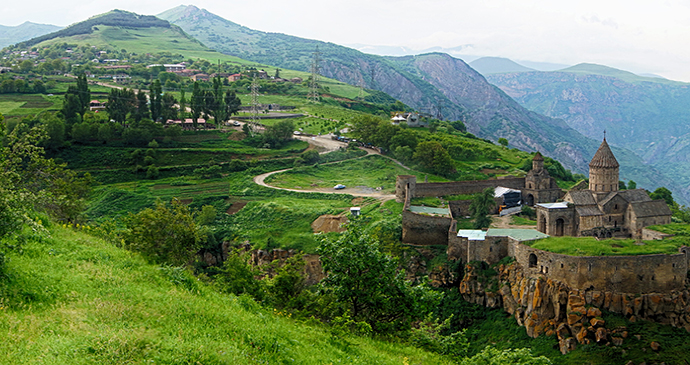
On the north façade are also representations of the founders of the church – Prince Ashot, his wife Shushan, Grigor Supan (the ruler of Gegharkunik), and Prince Dzagik. In 930, the walls of the church were decorated with frescoes but these have almost totally vanished except for some scant remnants in the apse, and the interior is now rather plain. Grigor Tatevatsi is buried inside the small chapel on the south side of the main church. His tomb is the highly decorated structure which abuts the church.
Yerevan
Armenia’s rapidly modernising capital sits at the foot of the mountains on the edge of the Ararat plain, straddling the gorge of the Hrazdan River which flows southwest from Lake Sevan to join the Arax south of the city.
The deep gorge skirts the centre of Yerevan on its western side and consequently many visitors only see it as they cross Victory Bridge into the city from Zvartnots International Airport.
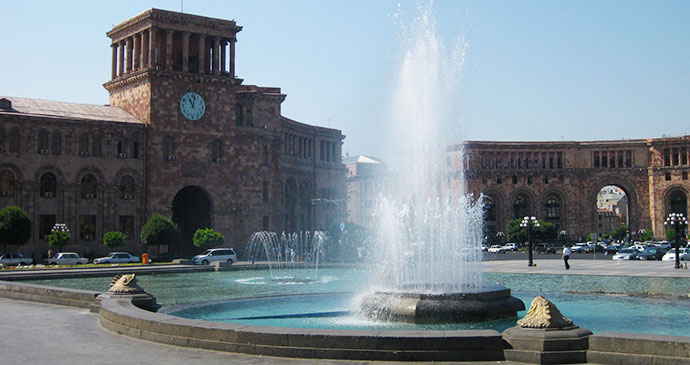
Yerevan is the cultural and financial capital of Armenia and has in recent years developed into a pleasant, thriving and visitor-friendly hub of cosmopolitan life. Particularly around Republic Square, the central area also boasts some of the finest Soviet-era buildings in the whole of the former USSR, and among the new high-rise apartment blocks there is a surprising range of older architecture, owing largely to the fusion of Armenian and Russian styles, with a sprinkling of Persian influence too.
Related books
For more information, see our guide to Armenia:
Related articles
Armenia has a wealth of monasteries – here’s our hitlist of what not to miss.
Discover our favourite sights along one of the most important trading routes in history.
You marvelled at the Taj Mahal, partied in Phuket and wandered along the Great Wall of China. But there are plenty of other places to discover in Asia.
Discover the best things to see and do in Nagorno Karabagh, one of the most unexplored regions of the Caucasus.
Learn more about khachkars, one of Armenia’s most important and conspicuous architectural features.
